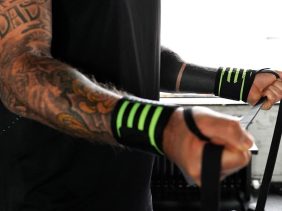Upper Body Workout For Women: 8 tips & 7 moves to give you results!
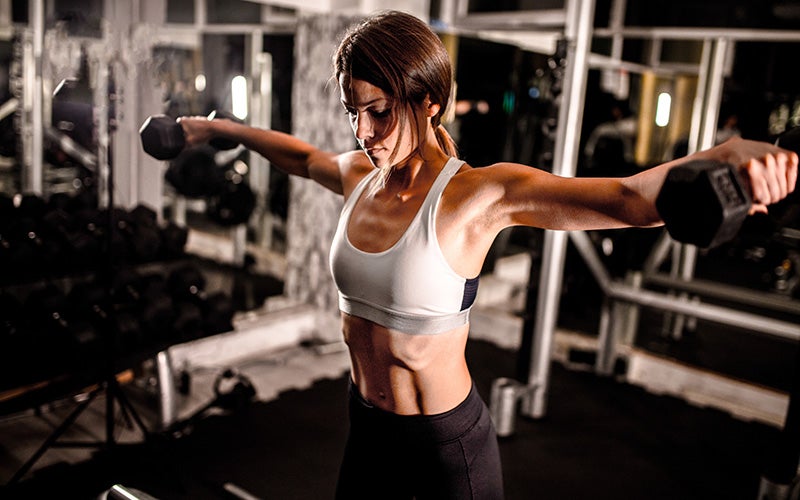 ©Viktorcvetkovic
©Viktorcvetkovic
Toned arms, sculpted shoulders, and a strong back aren’t just about how you look in a selfie, they’re also a fundamental part of a healthy posture. If you want to achieve pretty much any fitness goal, upper body training needs to be on your schedule. Here’s everything you need to know to get started with an upper body workout for women – with the most effective exercises for the gym and at home!
Upper Body Muscles
Upper body workouts target the arms, shoulders, chest, back, and abdomen, basically everything above the hips. The triceps that play a crucial role, then it’s your deltoids, rotator cuff, and lats that help maintain a healthy posture and stable back.
These are the most important upper body muscles:
- Triceps (M. triceps brachii): Your triceps extends the elbow joint.
- Biceps (M. biceps brachii): Your biceps flexes the elbow joint.
- Pectoral muscles (M. pectoralis major): Your pecs support your arms and breath.
- Lats (M. latissimus dorsi): Your lats have the largest surface area of all the muscles in your body. They extend from the upper arms through the thoracic and lumbar vertebrae to the sacrum and ilium.
- Shoulder and neck muscles (M. trapezius, M. rhomboideus, M. deltoideus): The deltoids (deltoideus), the traps (trapezius), and the rhomboid muscle (rhomboideus) stabilize your shoulder blades and straighten your upper spine.
- Rotator cuff (M. infraspinatus, M. supraspinatus, Musculus subscapularis, Musculus teres minor): The rotator cuff is responsible for stabilizing the shoulder joint.
- Abdominal muscles (M. obliquus externus abdominis, M. rectus abdominis): The straight and lateral abdominal muscles stabilize, flex, and rotate the trunk.
- Forearm muscles: The muscles in your forearm are the foundation for your grip strength, which is what you need, for example, if you want to work on pull-ups.
Effects of Upper Body Exercises
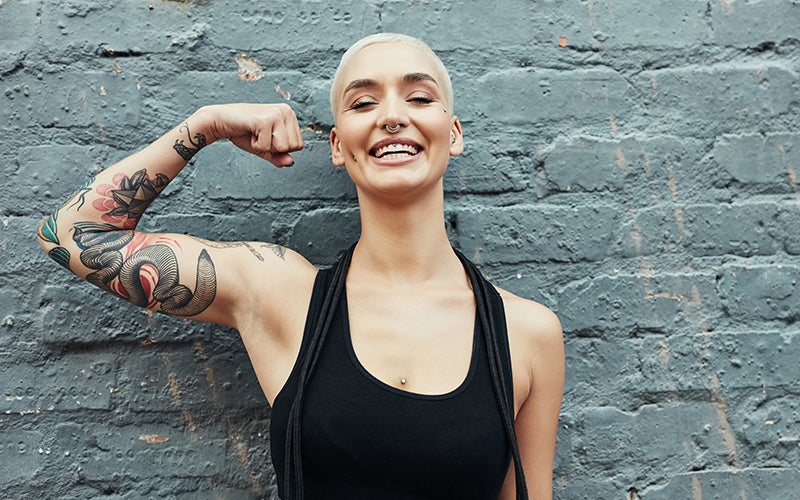
We’ve heard of people shying away from upper body exercises because they’re afraid of developing bulky upper-body muscles. Put your worries to rest. First off: Strong is strong, no matter how your muscles look. And second: It likely won’t happen. The hormone balance in most women’s bodies naturally give them more body fat and less muscle mass. Lower levels of testosterone, a growth hormone which ensures that protein is turned into muscle cells, also mean that most women don’t develop big muscles from strength training.
Instead, working out your arms, shoulders, and torso can help you reach your feel-good weight by burning fat. The greater the percentage of muscle mass your body has, the more calories you’ll need to maintain it. Every extra kilo of muscle burns extra calories, even at rest.
Our training tip: Sculpt your upper arms with our top exercises for the triceps!Bid Bingo Wings Farewell
Upper body strength training for women also helps fight tension in the neck, bad posture, and back pain from sitting a lot at work or at university, as well as protecting your joints. All of that comes in handy if you are, or get, pregnant or have to carry kids or other heavy loads around. But well-developed back muscles aren’t just about making your daily routine easier.
Because on top of that, your athletic performance in other disciplines can improve as well: from yoga and Pilates to martial arts and ball sports. And having solid core and arm muscles can even make a huge difference for runners.
What is Important in an Upper Body Workout for Women?

How effective your full upper body workout is depends on how mindful and holistic you are about it. Pay attention to the following factors:
- The shoulder joints and lower back are especially prone to injury. Start every workout with a warm-up to get all of your body parts moving. Good exercises for this include arm circles and warm-up sets with light weights.
- Always pay attention to proper form, because it’s much more important than weight and number of repetitions. Start new exercises with lighter weights than you’re used to.
- If you’re a beginner, integrate your upper body workout into a full body workout first.
- Organize your upper body workouts from big muscles to small. This means working your abs, back, and chest muscles first, then your arms and shoulders. In a full-body workout, start with your lower body first.
- If you’re an advanced athlete working with a split training plan, reserve one session for your back and chest muscles, one for biceps, triceps, and shoulders, and a third for abdominals, back, and lower body.
- New training stimuli are necessary for muscle growth so make sure you have enough variety with bodyweight, cable pulley, and barbell and dumbbell exercises.
- If you want to see progress quickly, two training sessions per week for the upper body are a good idea. Defined muscles also require sufficient regeneration time and a combination of enough sleep, active rest, and the right nutrients, with our Recovery Aminos for example.
- If you want to build upper body strength, a diet high in protein is an essential component of your fitness plan: Click here for our nutrition plan for muscle building! If you want to reach your feel-good weight instead, check out our nutrition tips for weight loss here.
7 Upper Body Exercises
Ready for your new triceps, shoulders, back and ab workout? Then it’s time to get started! Here are our top 7 exercises to do at home or at the gym:
#1 Bench Dips
Perfect for toned triceps and a strong upper back: Support yourself with your hands on a weight bench or the edge of a chair, your back up against the side of the bench. Your arms are behind your torso with your fingertips facing forward. Rotate your elbows inward minimally. Keep your legs bent or stretched out with feet shoulder width apart – the further away your feet are, the more intense the exercise. Slowly lower yourself by bending your elbows while keeping your back straight. Do not lower all the way, but press straight back up to the starting position without fully extending your elbows instead.
#2 Triceps Extensions
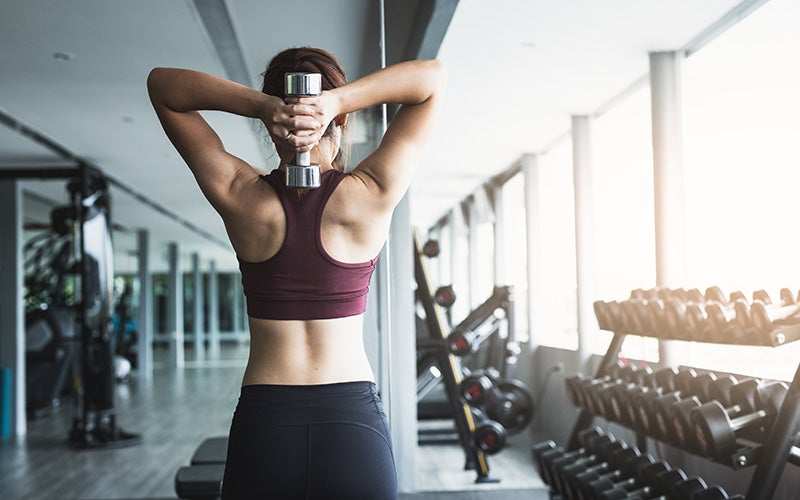
Grab a dumbbell with both hands and extend your arms above your head. Keep your upper arms to the sides of your ears and point your elbows forward. While keeping your shoulders stable and tensing your triceps, bend both elbows and bring the dumbbell toward your neck without your upper arms changing position. Come back to the starting position and repeat.
#3 Biceps Curls
Grab two dumbbells and grip them with your palms facing forward. Sit on a workout bench or stand hip-width apart. Roll your shoulders back and let your shoulder blades slide down your back. Anchor your elbows firmly at your waist. First extend your arms and briefly activate your triceps. Now bend your arms at the same time and lift the weights up to your shoulders. Hold the position briefly and lower the dumbbells back out to extension in a controlled manner.
#4 Shoulder Press
Grab a dumbbell in each hand or one barbell. Come into the starting position with your upper arms parallel to the floor, elbows bent at 90 degrees, and your palms facing forward. Consciously push your chest muscles out, keeping your core engaged, knees slightly bent, and feet shoulder width apart. Bring the weight up in an overhead press and slowly lower it back down.
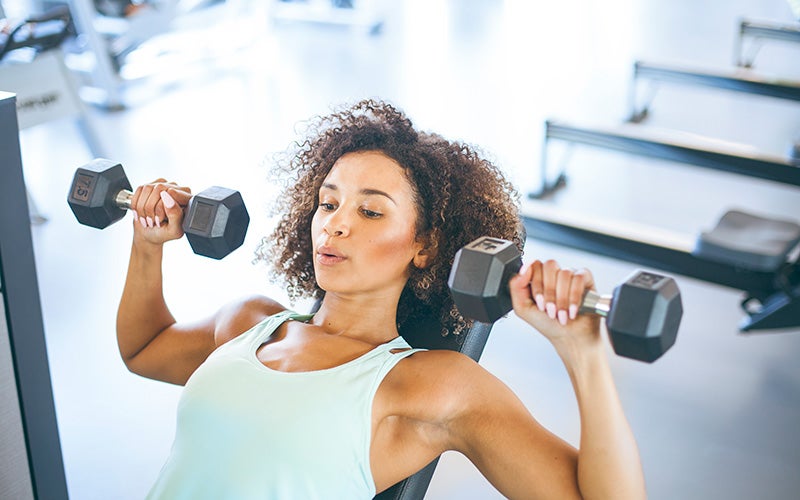
#5 Military Plank
Starting position is a forearm plank: elbows below your shoulders, abs and glutes engaged. Now come up a level by placing first one, then the other hand palm down on the mat – until you are in high plank on your palms. From here, go down again step by step back into the starting position. Important: Always keep your hips parallel to the floor. Work slowly and consciously tighten your abs and glutes to maintain stability.
#6 Hyperextensions
Perfect for a strong back: Lie prone on a mat and raise your head slightly. Bring your fingertips to your temples, keep your arms beside your body or stretch them above your head and lift them off the floor. Now move your upper body off the mat. Keep your gaze on the floor and your neck relaxed. Hold the final position for a few breaths before slowly lowering your upper body in a controlled manner.
#7 Supported Pull-ups
If you can’t do a full pull-up yet, this is the variation for you: Grab a strong resistance band and attach it to the pull-up bar. Place the lower loop around your feet or knees. Grab the pull-up bar at about shoulder width in an overhand grip, palms facing away from you. Now bend your arms and pull yourself towards the bar with your chest. Briefly hold the final position and slowly lower yourself back down in a controlled manner.
Our Tip: Learn everything about this classic exercise and how to work your way up to your first pull-up in this article.All about Pull-Ups
Conclusion
- An upper body workout for women specifically targets triceps, back, abs, and shoulders.
- Upper body training tones your arm and shoulder muscles, stabilizes your back, prevents joint problems, tension or back and neck pain, as well as improving your performance in other sports.
- Two upper body sessions per week are perfect for building strength. Make sure you vary the workouts and don’t over- or under-exert yourself.
- A warm-up, enough recovery time, and a goal-oriented diet are all important for keeping your upper body strong.
Sources for this article
We at foodspring use only high-quality sources, including peer-reviewed studies, to support the facts within our articles. Read our editorial policy to learn more about how we fact-check and keep our content accurate, reliable, and trustworthy.


























